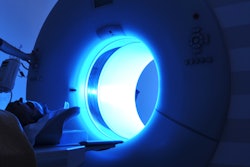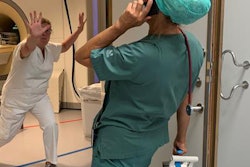
A new analysis of more than 18,000 MRI scans conducted over a year has shown that incident reports are much more common among hospital inpatients, largely due to clinical problems with patients in transit and the lack of identification and information, while most incidents among outpatients are due to booking issues.
Senior MRI radiographer Apollo Exconde and his colleagues at InHealth, a U.K. provider of fully managed MRI services, aimed to present a full year's experience of online incident reporting for the InHealth MRI unit at Croydon Health Services National Health Service Trust, a 670-bed hospital with three MRI machines, one of which is an open MRI unit. They presented their findings at the recent UK Imaging & Oncology Congress in Liverpool.
To identify and learn about any themes or trends that could pose harm to either patients or staff, the researchers evaluated data from MRI incident reports filed between December 2017 and November 2018. Incident reports were processed using an online platform (Sentinel) and then categorized according to the primary incident type and then further divided by secondary incident type.
The total number of incidents included in the study was 224 from a total of 18,623 scans -- an incidence rate of 1.2%. In all, 16,958 (91%) of the scans were for outpatients. Clinical staff were responsible for filing most reports (98.7%), and the remainder came from the administrative team.
Of the 224 incidents, 33 (14.7%) were related to open MRI. The highest number of incidents (34, 15%) was logged in May. The table below gives a full breakdown of incidents reported for inpatients and outpatients.
| Primary MRI incident type December 2017 to November 2018 |
||||
| Type | Outpatient | Inpatient | Other | Total |
| Clinical incident | 13 | 76 | 89 | |
| Booking issue | 43 | 4 | 47 | |
| MRI safety incident | 10 | 16 | 1 | 27 |
| Equipment incident | 24 | 24 | ||
| Health and safety incident | 6 | 3 | 7 | 16 |
| Image-related incident | 5 | 5 | ||
| Abuse or harassment | 3 | 3 | ||
| Clinic cancellation | 2 | 2 | ||
| Report-related incident | 2 | 2 | ||
| Breach of confidentiality | 1 | 1 | ||
| Safeguarding | 1 | 1 | ||
| Other | 2 | 5 | 7 | |
| Total | 224 | |||
Of the 12 categories of primary incidents, six of them involved outpatients only, while the other five affected both inpatients and outpatients. The equipment incident category had no patient involvement because it was due to equipment problems.
"Astonishingly, the outpatient group was not the leading cause of incident reports based on the top four incidents filed," Exconde said. "According to the data, a prominent feature is that a significantly high number of inpatients faced clinical incidents. Breach of confidentiality and safeguarding had the least reported incidents with one, and both of them had outpatient involvement only."
Most booking issues occurred with outpatients, while the number of patients with MRI safety issues was slightly higher among inpatients.
The highest percentage of secondary incidents was due to incomplete or inaccurate documentation (34 cases, 38.2%) because many patients came to the MRI unit without wearing identification bands. Another 26 patients (31.5%) experienced patient procedure or pathway delays, while 12 incidents (13.5%) were due to the collapse of patients or their deterioration due to contrast agent administration. A further 14.8% of incidents were because patients were mistakenly scheduled for the conventional scanner when they really needed the open MRI system.
Only eight incidents were related to implants or devices, mostly as a result of lack of information and contraindications.
Overall, inpatients dominated both primary and secondary incidents, but no real harm or legal implications resulted from the incidents.
"Incident reporting is encouraged to improve patient safety," Exconde noted. "An assessment of incident reports provides valuable awareness into quality improvements that can be made within an imaging service. Understanding the various types and frequency of incidents that arise is important to learn from and share with others to prevent future incidents."
Due to underreporting, the data may not necessarily represent all adverse outcomes, and this study bias may limit the impact of incident reports for the unit's improvement, he added.
To improve the situation, the group has updated the MRI prescan questionnaire slips for a focused management appointment journey for anxious or obese inpatients from the ward to the MRI suite. In future, they plan to encourage more incident reporting, educate people better in completing the relevant forms, and implement a system to standardize the categories of incidents.
Exconde has a special interest in assisting patients with claustrophobia who have to undergo an MRI scan. Earlier this year, he promoted the idea of using an open MRI Lego design to enable people to overcome their fears.



















